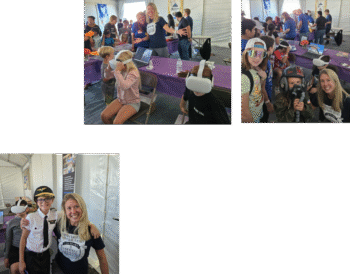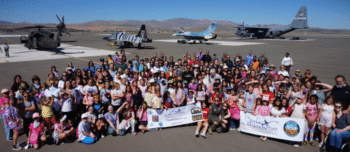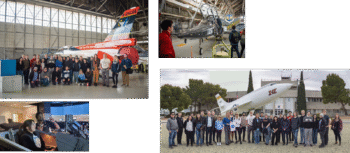On the surface, STEM outreach may look like building paper rockets with kids or hosting an airshow booth filled with flight simulators and plastic wing models. But underneath, these moments carry the weight of something far more critical: securing our nation’s future innovation, strengthening our technical workforce, and ensuring that science and engineering are accessible—and exciting—for the next generation.
I’ve been fortunate to spend the past year deeply engaged in STEM outreach across the Reno area and the University of Nevada, Reno (UNR), building programming that reaches thousands of students across all grade levels. My motivation is both personal and professional. I know what it’s like to want to make a difference, and I also know, as a flight test engineer and Ph.D. student working on aerospace autonomy, just how urgently we need to cultivate talent and diversity in science, technology, engineering, and math.
The Case for Outreach: A National Security and Workforce Imperative
We often talk about STEM outreach as something “nice to do”—a feel-good effort to inspire kids or give back. But make no mistake: it’s also a strategic necessity. The United States is not producing enough STEM graduates to meet future workforce demands. According to the U.S. Census Bureau, STEM jobs are expected to grow at twice the rate of non-STEM jobs, yet many reports suggest we trail other countries in STEM preparation to fill those roles [1] [2] [3].
This isn’t just an education issue—it’s a national security issue. Our ability to innovate in aerospace, defense, energy, and climate depends on a technically capable workforce. To close the gap, we must actively engage broader and more diverse student populations—not just those who already see themselves as “good at math.”
Historically underrepresented groups—across gender, ethnicity, income, and geography—are an untapped opportunity to expand our technical base. For example, while women make up half the U.S. workforce, they represent only 27% of scientists and 15% of engineers [4] [5]. In general aviation, women account for just 9% of all pilots [6] . Closing these gaps is not just about fairness—it’s about adding voices, perspectives, and ideas that strengthen technical teams and fuel innovation.
As someone who’s worked on high-stakes aviation projects, I’ve seen firsthand that diverse teams identify risks and solve problems more effectively. Groupthink is a real hazard, and diversity—of thought, background, and experience—acts as a safeguard. In engineering, as in flight test, blind spots can have consequences.
What Effective Outreach Looks Like

Over the past year, I’ve helped design and lead STEM outreach programs that prioritize hands-on, real-world exposure to science and engineering. At Stead Airport we host an annual STEM Discovery Zone at the Reno Air Show. In 2024, we welcomed more than 7,500 students into that space. Kids explored aerospace exhibits, flew virtual test missions using augmented reality headsets, and met college students building rockets. The goal is simple: let students experience what STEM feels like—curious, fast-paced, and alive. Experience the 360 video I share here: https://www.youtube.com/watch?v=eKHHRR8On9U

Another annual event, Girls in Aviation Day, welcomes over 250 local students each year to the ramp and hangars, where they get to sit in cockpits, talk to engineers and pilots, and learn how math and physics apply to real flight. The programming is open to all students, and we focus on removing barriers to entry for anyone who may not have considered aviation or engineering as an option.
In the classroom, I’ve partnered with local schools to deliver tailored outreach for K–12 students. Whether it’s building gliders with second graders or discussing engineering tradeoffs with high school students, the approach is the same: meet students where they are and connect STEM to something they care about. I’ve also served as co-host for the Night of the STEM Stars, a recognition gala for high school and community college students, where we celebrate real student success and give them a platform to be seen and valued.

50+ High School Students
25+ Community College Students
In addition to engaging younger students, I also work to connect college students with real-world STEM career opportunities. Last year, I organized a trip for more than 25 students from the UNR Aerospace Club on a tour of “Aerospace Valley,” a region in Southern California that includes the Mojave Air & Space Port and Edwards Air Force Base. The trip gave students an inside look at the National Test Pilot School, NASA Armstrong Flight Research Center, and the U.S. Air Force Test Pilot School, where I serve as a part-time instructor. From conversations with pilots and engineers to walking the same flightlines where historic research aircraft are tested, students left with a clearer understanding of the range of careers in aerospace and flight test. Opportunities like this help bridge the gap between academic learning and the professional world—transforming abstract career goals into tangible, achievable futures.

Why It Works
Effective outreach isn’t just a matter of giving a one-off talk. Research shows that repeated engagement, visible role models, and hands-on experience are the biggest predictors of whether a student will pursue STEM [7] [8].
– Real-world relevance makes STEM feel applicable, not abstract.
– Early exposure—especially during late elementary and middle school—is critical.
– Visible practitioners help students imagine themselves in the field.
– Community partnerships amplify reach.
A Personal Note
It wasn’t until seventh grade, during a STEM program hosted by Lockheed Martin Skunk Works, that I realized engineering might be my path. I remember touring the Palmdale facilities, learning about design and manufacturing, and signing a plate that we were told was going to space (unconfirmed, but thrilling). That was the first time I connected my ability in math to something bigger—real-world impact.
It’s no coincidence that I now aim my outreach at students that same age. Middle school is a formative time when identities are shaped and possibilities either expand or narrow. Outreach gives me the chance to be that guide for someone else—to plant the seed that STEM is not only accessible, but exciting and world-changing.
Whether it’s through a short flight sim demo or an in-depth Q&A with a classroom, I believe that every engagement matters. Sometimes all it takes is a single conversation to shift a student’s trajectory.
To everyone already involved in STEM education and outreach: thank you. And to those wondering how to start—your story, your experience, and your presence can make a difference. The next generation of scientists, engineers, and explorers is already watching. Let’s give them something to aim for.
By Jessica Peterson
References
[1] U.S. Bureau of Labor Statistics. STEM Job Statistics. https://www.bls.gov/emp/tables/stem-employment.htm
[2] OECD. Countries That Award the Most STEM Degrees (2022). https://www.oecd.org/education/countries-that-award-most-stem-degrees
[3] OECD. PISA 2018 Results (Volume I): What Students Know and Can Do. https://www.oecd.org/publications/pisa-2018-results-volume-i-5f07c754-en.htm
[4] Women Making Gains in STEM Occupations but Still Underrepresented. (2021) https://www.census.gov/library/stories/2021/01/women-making-gains-in-stem-occupations-but-still-underrepresented.html
[3] The State of Girls in STEM: A Conversation to Plan Action (2023) https://ngcproject.org/action
[4] FAA Airmen Certification Statistics (2023). https://www.faa.gov/data_research/aviation_data_statistics/test_statistics/annual_statistics_2023.pdf
[5] President’s Council of Advisors on Science and Technology (2012). Engage to Excel: Producing One Million Additional College Graduates with Degrees in STEM. https://obamawhitehouse.archives.gov/sites/default/files/microsites/ostp/pcast-engage-to-excel-final_2-25-12.pdf
[6] Tai, R. H., et al. (2006). Planning Early for Careers in Science. Science, 312(5777), 1143–1144. https://www.science.org/doi/10.1126/science.1128690
